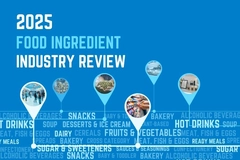
- Industry news
Industry news
- Category news
Category news
- Reports
- Key trends
- Multimedia
Multimedia
- Journal
- Events
- Suppliers
- Home
- Industry news
Industry news
- Category news
Category news
- Reports
- Key trends
- Multimedia
Multimedia
- Events
- Suppliers
Hydrocolloids break out into new categories, fueled by plant-based success

05 May 2020 --- Hydrocolloids are widely used to modify the rheology of food and beverages, namely to improve stability, flow and texture of food and beverage formulations. Given the surging plant-based revolution and the evolution of clean labels – among other prominent industry themes – applications for the multi-functional ingredients are flourishing. FoodIngredientsFirst speaks to key suppliers to examine the latest trend-oriented product developments in this dynamic market space.
Hydrocolloids commonly appear on ingredient labels for their ability to bind with water, thicken and gel. “This can be done for a variety of reasons, from contributing to the appearance or mouthfeel of food and beverages to even helping improve mealtime for people suffering from dysphagia by making their food easier to swallow without choking,” explains Jérôme Béra, Senior Vice President, Global Marketing at CP Kelco.
“The role of hydrocolloids has greatly expanded to help formulators solve other challenges. This can include improving shelf stability of drinking yogurts or helping to keep gummy candy from melting in warmer climates or helping plant and nut proteins become viable dairy alternatives,” he adds.
 The role of hydrocolloids has greatly expanded to help formulators solve other challenges.According to Innova Market Insights data, indexed F&B launches tracked with hydrocolloids saw a 7 percent average annual growth between 2015 and 2019. The fastest growing market categories for the ingredient are listed in order as Sports Nutrition (+19 percent), Baby & Toddlers (+15 percent), Snacks (+13 percent), Hot Drinks (+11 percent) and Dairy (+10 percent). Meanwhile, gellan gum is pegged as the fastest growing hydrocolloid, as maltodextrin and corn starch are coined the top performing ingredients of this category.
The role of hydrocolloids has greatly expanded to help formulators solve other challenges.According to Innova Market Insights data, indexed F&B launches tracked with hydrocolloids saw a 7 percent average annual growth between 2015 and 2019. The fastest growing market categories for the ingredient are listed in order as Sports Nutrition (+19 percent), Baby & Toddlers (+15 percent), Snacks (+13 percent), Hot Drinks (+11 percent) and Dairy (+10 percent). Meanwhile, gellan gum is pegged as the fastest growing hydrocolloid, as maltodextrin and corn starch are coined the top performing ingredients of this category.
With a swathe of options to choose from, the end product is what usually drives the choice of hydrocolloid in formulation. “Hydrocolloids have different tolerances to temperature, pH, salt and other processing conditions. For example, pectin is not recommended for a neutral pH environment. We can help guide customers to what works best for their unique needs,” says Béra.
“In confectioneries, pectin is more frequently selected to replace the animal-derived gelatine in gummies, with multiple advantages: a vegetal origin, most appreciated by consumers; a fast flavor release, that makes a great showcase for the candy maker; and a higher melting point, that makes it ‘hot car safe’ in warmer climates,” says Dino Asvaintra, President of DSM Hydrocolloids.
In meeting the challenging demands of high-solid applications, DSM has designed a new type of gellan gum, Gellaneer HS. The ingredient is marketed as having unique gelling properties and optimal handling characteristics that make it an ideal texturizing agent for spreads, jam, bakery fillings, cream cheese and gummies. Moreover, it imparts a creamy mouthfeel to low-fat formulations without compromising the spreadability, while providing an ideal substitute for ingredients like gelatin and carrageenan.
Another major reason where one type of hydrocolloid might be preferred over another is if a brand is seeking to reduce the number of ingredients in order to meet clean label goals, notes Béra. “It would be advantageous then to find one nature-based hydrocolloid that can accomplish the work of two or three. For example, our Kelcogel DF Gellan Gum serves dual functions. It provides long-term suspension and a clean, pleasant mouthfeel. It can be useful when formulating a beverage with plant proteins, which can leave behind a grassy or nutty taste and gritty texture that would turn off consumers.”
CP Kelco has also launched a next-generation Nutrava Citrus Fiber derived from citrus peel and offering unique thickening, stabilizing and water-binding capabilities. “This functional fiber is a great new tool for formulators looking for ingredients to assist in the creation of products with ‘clean labels,’ such as mayonnaise and salad dressing, or ingredients without an E-number in Europe,” remarks Béra.
“Our ingredient can be listed as citrus fiber on the label and it supports daily intake of fiber. It can also be used to replace starch, eggs or oil. With continued growth in consumer demand for clean label products, citrus fiber addresses the formulator’s need for recognizable, nature-based ingredients. We think the future application possibilities are endless,” he envisions.
Trends in hydrocolloids Hydrocolloids commonly appear on ingredient labels for their ability to bind with water, thicken and gel.
Hydrocolloids commonly appear on ingredient labels for their ability to bind with water, thicken and gel.
Trends in hydrocolloids typically follow market and consumer trends, Béra comments. “We know that consumers now favor ingredients which sound familiar. For example, pectin, which is typically a byproduct of the citrus juicing industry, is very much on-trend right now as it is something with which most consumers are familiar. They can remember that their grandmother used pectin to make jam. This kind of brand storytelling lends to its popular appeal.”
CP Kelco is the manufacturer of Genu Pectin – an upcycled ingredient, meaning that it is produced from spent citrus peel after juicing and de-oiling. Upcycling, emerging as the “new recycling” in Innova Market Insights’ “The Sustain Domain” trend, fits well within CP Kelco’s holistic “Triple Bottom Line” strategy. As detailed by the company in its exclusive FoodIngredientsFirst webinar, sustainable manufacturing necessitates “life cycle thinking.”
“One grade of pectin is increasing in popularity. We have been receiving more requests for an alternative to gelatin in recipes. This is due to consumer diet preferences such as vegan/vegetarian, kosher and halal as well as a growing concern for animal welfare. Some customers are also concerned about the price increase in gelatin. Genu Explorer Pectin ND-200 can be used to create a similar, gelatin-like texture profile in dairy desserts,” says Béra.
Moving ahead, the rising consumption of convenience food and increased consumer literacy for ingredient labeling are among the factors favoring the growth of naturally-sourced, brand-friendly and sustainable hydrocolloids.
“From a supply chain reliability and price stability perspective, food manufacturers are inclined toward biogums on the market, over plant-extracted hydrocolloids, which are relatively immune from the effects of climate change. For plant-extracted hydrocolloids, given its relatively long supply chain, it’s essential for suppliers to ensure a stable and secured supply chain to mitigate the supply volatility due to environmental challenges,” says Asvaintra at DSM Hydrocolloids.
In addition to F&B sectors, Asvaintra also anticipates broadened hydrocolloids applications in the fast-growing health and wellness sector, where product formulators increasingly seek solutions to diversify the current product formats in delivering nutrition for wide consumer bases like the silver population, athletes and sport lovers (e.g. energy gels), and consumers seeking an immunity boost and for weight management.
“Those hydrocolloids with versatile functionalities like gellan gum, pectin and xanthan gum are now increasingly critical to deliver optimal results, responding to this trend,” he concludes.
By Benjamin Ferrer










